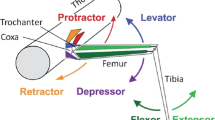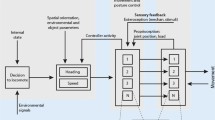Abstract
Elongation of the femoral chordotonal organ (signalling a flexion movement of the femur-tibia joint) in stick insects being active releases the active reaction (AR) in the extensor and flexor motor neurones. The AR was released in hindlegs in a situation where free animals would preferentially walk backwards. In most cases the coordination between extensor-flexor and the retractor unguis muscle was like in a stance phase of backward walking. In a situation where free animals would preferentially walk forwards, the percentage of ARs was smaller, and resistance reflexes became more frequent. When campaniform sensilla of the hind leg were destroyed coordinations like in a swing phase of forward walking became more frequent. — Additional stimuli during searching movements in an artificially closed femur-tibia feedback system (Weiland et al. 1986) showed that the AR is expressed also under these conditions and controls velocity and endpoint of a flexion movement. All results support the idea that the neural system producing the AR is a functional element of the pattern generator for forward walking, of the one for backward walking and of the one for searching movements. As far as this system is concerned the three pattern generators only differ in the kind of coordinating pathways between constant functional elements.
Similar content being viewed by others
References
Bässler U (1967) Zur Regelung der Stellung des Femur-Tibia-Gelenkes der StabheuschreckeCarausius morosus in der Ruhe und im Lauf. Kybernetik 4:18–26
Bässler U (1977) Sense organs in the femur of the stick insect and their relevance to the control of position of the femur-tibia-joint. J Comp Physiol 121:99–113
Bässler U (1983) Neural basis of elementary behavior in stick insects. Springer, Berlin Heidelberg New York
Bässler U (1986) Afferent control of walking movements in the stick insectCuniculina impigra. II. Reflex reversal and the release of the swing phase in the restrained foreleg. J Comp Physiol 158:351–361
Bässler U (1988) Functional principles of pattern generation for walking movements of stick insect forelegs: the role of the femoral chordotonal organ afferences. J Exp Biol 136:125–147
Bässler U, Koch UT (1989) Modelling of the active reaction of stick insects by a network of neuromimes. Biol Cybern 62:141–150
Bässler U, Storrer J (1980) The neural basis of the femur-tibia-control-system in the stick insectCarausius morosus. I. Motoneurons of the extensor tibiae muscle. Biol Cybern 38:107–114
Bässler U, Wegner U (1983) Motor output of the denervated thoracic ventral nerve cord in the stick insectCarausius morosus. J Exp Biol 105:127–145
Bässler U, Foth E, Breutel G (1985) The inherent walking direction differs for the prothoracic and metathoracic legs of stick insects. J Exp Biol 116:301–311
Buddenbrock W von (1921) Der Rhythmus der Schreitbewegungen der StabheuschreckeDyxippus. Biol Zentralbl 41:41–48
Büschges A (1989) Processing of sensory input from the femoral chordotonal organ by spiking interneurones of stick insects. J Exp Biol 144:81–111
Cruse H, Pflüger H-J (1981) Is the position of the femur-tibia-joint under feedback control in the walking stick insect? II. Electrophysiological recordings. J Exp Biol 92:97–107
Cruse H, Schmitz J (1983) The control system of the femur-tibia-joint in the standing leg of a walking stick insectCarausius morosus. J Exp Biol 102:175–185
Foth E, Bässler U (1985) Leg movements of stick insects walking with five legs on a treadwheel and with one leg on a motor-driven belt. I. General results and 1∶1 coordination. Biol Cybern 51:313–318
Graham D, Bässler U (1981) Effects of afference sign reversal on motor activity in walking stick insects (Carausius morosus). J Exp Biol 91:179–193
Grillner S (1981) Motor control. In: Brooks UB (ed) Handbook of physiology. Sect. 1: The nervous system, vol 2. Williams & Wilkins, Baltimore, pp 1179–1236
Hofmann T, Bässler U (1982) Anatomy and physiology of trochanteral campaniform sensilla in the stick insectCuniculina impigra. Physiol Entomol 7:413–426
Pflüger H-J (1977) The control of the rocking movements of the phasmidCarausius morosus. J Comp Physiol 120:181–202
Weiland G, Koch UT (1987) Sensory feedback during active movements of stick insects. J Exp Biol 133:137–156
Weiland G, Bässler U, Brunner M (1986) A biological feedback control system with electronic input: the artificially closed femur-tibia control system of stick insects. J Exp Biol 120:369–385
Wendler G (1964) Laufen und Stehen der StabheuschreckeCarausius morosus: Sinnesborstenfelder in den Beingelenken als Glieder von Regelkreisen. Z Vgl Physiol 48:198–250
Author information
Authors and Affiliations
Rights and permissions
About this article
Cite this article
Nothof, U., Bässler, U. The network producing the “active reaction” of stick insects is a functional element of different pattern generating systems. Biol. Cybern. 62, 453–462 (1990). https://doi.org/10.1007/BF00197651
Received:
Accepted:
Issue Date:
DOI: https://doi.org/10.1007/BF00197651




